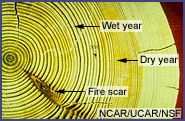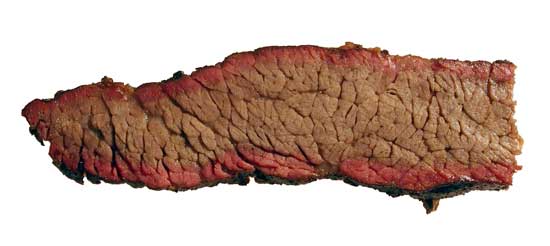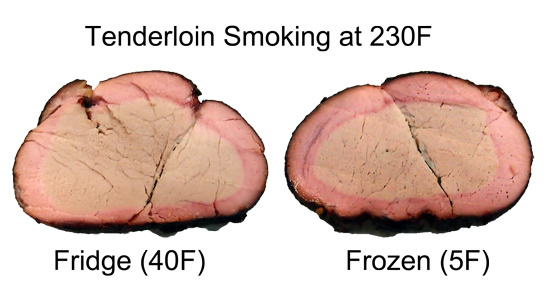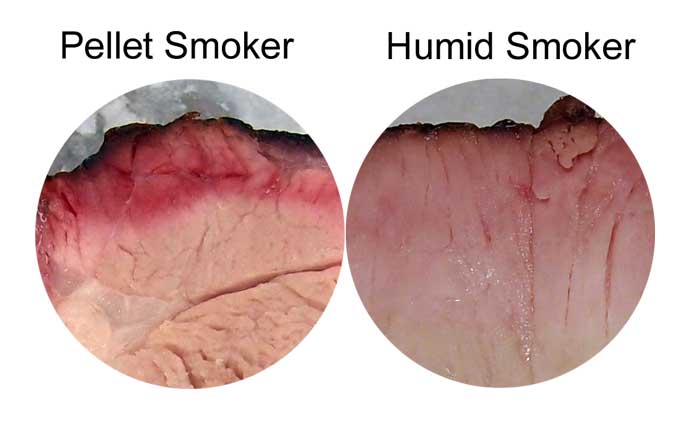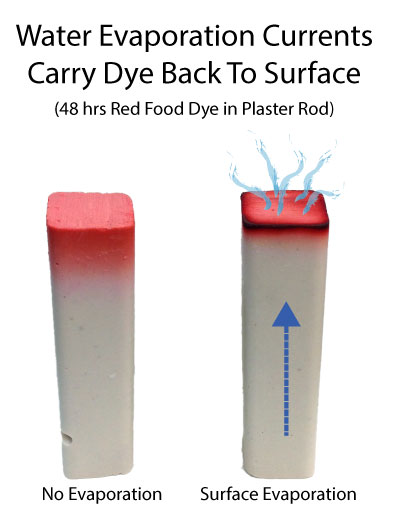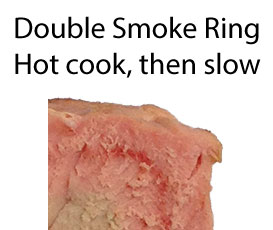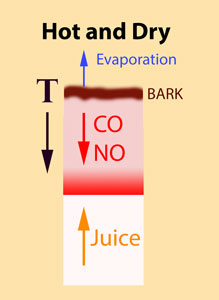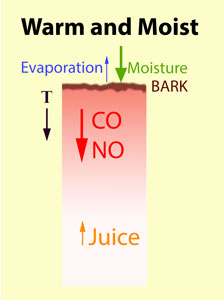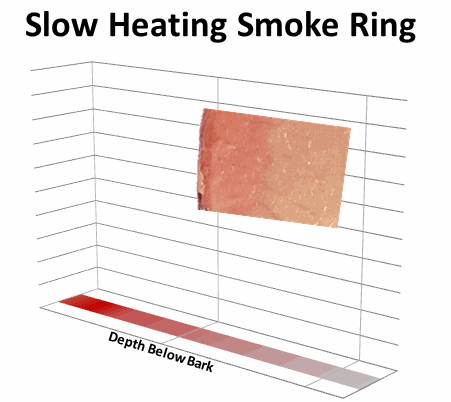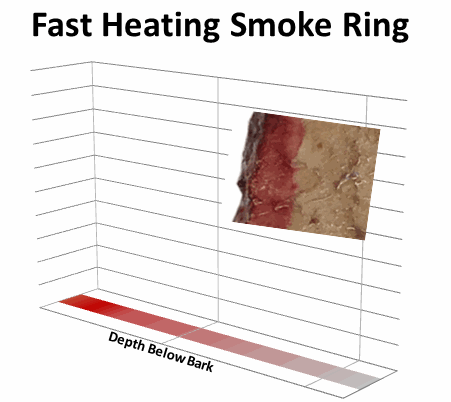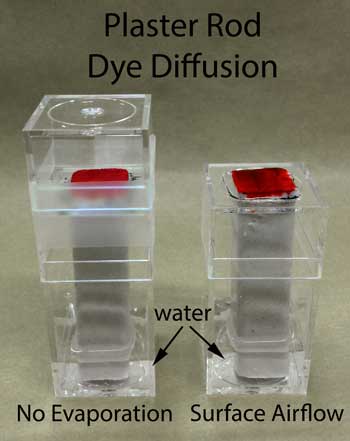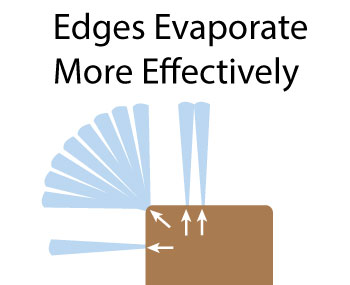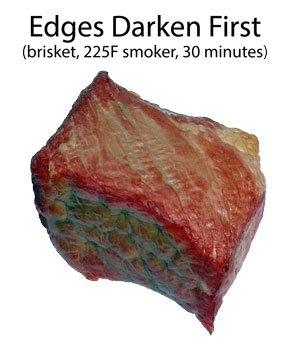| g e n u i n e i d e a s | ||||||
 |
 |
 |
 |
 |
 |
 |
| home | art and science |
writings | biography | food | inventions | search |
| lord of the rings | ||||
|
||||
|
May 2014 Summary of the mechanisms leading to smoke ring depth and profile:
Smoke rings record combustion conditions (particularly temperature and gases) as they vary during the cook. Like tree rings recording drought and fire. The species matters too- the ring will be a different color and depth depending on the species of meat, its age and how it was prepared for cooking. Roughly speaking, ring formation is simple. CO or NO gases are produced by wood combustion. They are absorbed on the meat's surface, and diffuse from the surface to the center. As they move through the meat (mostly between the muscle fibers via interstitial juices, but both molecules are highly mobile even in fat and through cell walls), these chemicals stabilize the color of the fragile red myoglobin molecule that normally stores oxygen in muscle cells.
If that was all there was to ring formation, the ring's depth would be determined by the length of smoking. Simple diffusion moves roughly in proportion to the square of distance. That is, a 1/2" ring takes four times longer to grow than a 1/4" ring. So you might conclude, correctly, that the ring is mostly formed in the first hour or so of cooking- it would take three more hours to double the ring depth. And its color would be darker in proportion to the CO/NO levels produced in the fire- which means a hot fire, like a big stick burner. Except some rings seem to expand forever, while others stop dead in their tracks. The are three factors controlling the smoke ring profile, all of which are partly under the pitmaster's control. First, even in a cooker dense with smoke, there can be a stagnant cushion of air around the food which deflects smoke particles and gases. Like a car windshield deflecting all but the largest insects while speeding down the road. Some cookers, for example, charcoal burners, have tiny vents and the air barely moves at all. This can reduce the smoke ring. Fast moving, turbulent air (like above an open pit fire) breaks up this "boundary layer". A dry surface reduces evaporation, and when meat evaporates, counter-currents draws smoke in to the surface. Similarly, cold meat deepens the smoke ring by condensation. You can observe both effects at work in this experiment. Here I compared two tenderloins smoked at the same time- one at fridge temps, one solidly frozen. The frozen meat took longer to cook and was colder for a longer time. The smoke ring is wider, and more importantly, thicker on the bottom of the frozen meat, counteracting the tendency for the wire shelf grate to impede smoke flow:
In this next experiment, two pork butts were smoked at 225F. Pellet smokers are relatively dry- around 5% relative humidity (RH). The humid pellet smoker was at nearly 20%. Note the wider and more smoothly graded ring in the humid smoker:
But wait, there's more. Heat as well as CO/NO is working its way to the center. If the heat moves faster than the gases (e.g. cooking "hot"), and raises the meat's surface above 170F early in the cook, the myoglobin is permanently destroyed, turns gray, and cannot be revived. Even after the gases arrive. This will narrow the smoke ring into a sharply-defined "wall". Alternatively, cooking low and slow allows the gases to outrace the heat, the ring is wider and darker near the surface, forming a "wedge" of color towards the center. A long "stall" below 155F will also lead to a wider smoke ring. Finally, there is drainage. As the meat cooks, juices, (including myoglobin) flow to the surface and evaporate. The rate increases dramatically as the meat reaches 130F when the collagen shrinks and wrings out the meat fibers. If this outward flow is strong enough, it will push back on surface juices containing dissolved CO/NO, so they never reach the interior. This counterflow causes the gas laden juices to pile up, and is responsible for the dark red line often visible along the ring's inside margin. This simple experiment1 illustrates how juice-flow can dramatically modify the ring profile. Small plaster rods substitute for the meat- they contain a fine network of water-filled pores occupying 40% of the volume (like intra-muscular juices). A little red food coloring was placed on the tip of each rod. One rod was sealed in a container (preventing evaporation, but still allowing the dye to diffuse). On the second rod, only the dyed surface was exposed to air. Evaporation drew moisture from the deep interior to the surface, counteracting the effect of diffusion. After 48 hours, the two rings could not be more distinct:
(note the dark red rim on the surface evaporation rod- discussed below in the footnotes) More complex geometries sometimes occur, similar to the tree ring modulation with drought and rain. This "double ring" was created by initially heating the meat quickly (300F) for an hour, then dropping to 225F. The dark ring is from the counterflow of juices, but once the temperature dropped, the flow is reduced and the ring started to penetrated deeper.
All of these effects are captured by this illustration:
I've modeled the fast and slow heating effect in these two animations. In the first simulation, the gases move through the meat faster than the heat, so the ring is wide and darkest at the surface (where the concentration of CO/NO is greatest). The color profile is wedge-shaped, dark at the surface and lighter towards the center.
In this second animation, heat moves faster than the gases. At some point the heat outruns the gas and the ring is frozen in time. The profile is uniform, and stands like a wall between the bark and the interior.
Smoke rings are pink myoglobin stabilized by exposure to CO/NO gases so the color does not fade quickly with time. Their profile depends on cooking conditions- particularly temperature and humidity. And while they contribute little flavor and may be chemically faked, smoke rings are a reasonable surrogate for claiming traditional barbecue cooked right.
|
||||
|
1 More details on the plaster rod experiment: Plaster of Paris was mixed with water (2:1 by weight) and squeezed into 1.5 cm2 rectangular molds. After a 3 hour curing period, the rods were released, cut with a hack saw and placed into clear plastic boxes. The lid of each box was notched just wide enough to allow the rod to stick out of the top surface. A bit of water was poured into the bottom of each box to keep the plaster hydrated, and one box was covered with an additional clear lid to prevent evaporation:
The surface of the airflow sample remained moist at all times. After 48 hours, the rods were removed and photographed. You might note the perimeter of the surface-airflow rod is darker red than the center. This is because evaporation is stronger on the edges. Simple geometry dictates there is a larger volume of dry air available to sop up moisture at the corners than the center. So greater water flow. Plus there is often a bit more turbulent mixing on corners. The same effect is visible on real meat samples, made a little bit more complex by the ease of juices carrying myoglobin flowing along, rather than around muscle bundles:
|
||||
Contact Greg Blonder by email here - Modified Genuine Ideas, LLC. |
